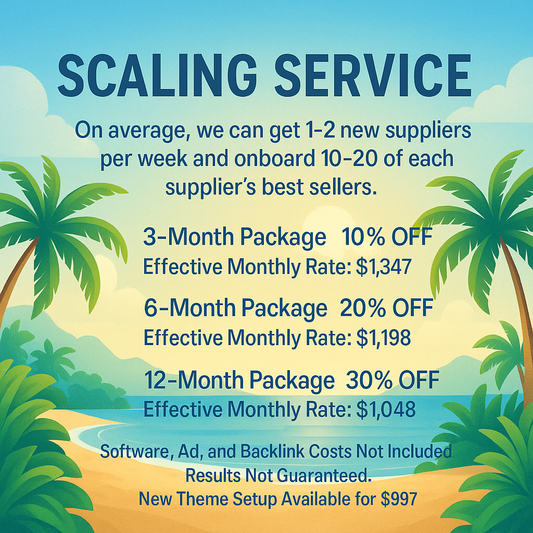
Crisis Management Strategies for High-Ticket Businesses
In the fast-paced world of ecommerce, particularly in the realm of high-ticket ecommerce, the ability to navigate crises effectively is critical to sustainability and long-term success. At Ecommerce Paradise, we understand that managing challenges, whether they be external market shifts or internal operational hiccups, requires a strategic approach. That’s why today we’re diving into essential crisis management strategies specifically crafted for high-ticket drop shipping businesses. Let’s gear up to tackle any storm that may come your way!
Understanding the Unique Challenges of High-Ticket Ecommerce
Before we jump into specific strategies, it's essential to recognize the unique challenges that high-ticket businesses face. High-ticket ecommerce often involves larger financial transactions and longer sales cycles compared to standard dropshipping operations. This means that the stakes are higher, and the consequences of a crisis can be more severe. Here are some of the common challenges:
- Customer Trust: Gaining and maintaining customer trust is crucial. High-ticket items require customers to feel confident in their investment.
- Supply Chain Vulnerabilities: High-value products often come from multiple suppliers, making the supply chain prone to disruptions.
- Market Competition: The higher price point means your competitors are often larger companies with more resources.
- Customer Expectations: Buyers of high-ticket items expect exceptional customer service and support, requiring your operation to be agile and responsive.
Preparation: The First Step to Managing Crises
Effective crisis management begins long before a crisis hits. Preparing your high-ticket ecommerce business involves some proactive steps that can save you time and headache later on. Here’s how you can get started:
Develop a Crisis Management Plan
Creating a clear and comprehensive crisis management plan is the cornerstone of your preparations. This plan should outline potential crisis scenarios, designated crisis management team members, and actionable steps for each scenario. Key topics your plan should cover include:
- Types of potential crises (e.g., supplier failure, negative publicity, tech issues)
- Roles and responsibilities within your crisis management team
- A communication strategy for both internal and external stakeholders
Continuous Monitoring and Risk Assessment
Keep a watchful eye on your business's operations. Regularly assess risks, and clue in on potential external factors that could lead to a crisis, such as shifts in consumer behavior or industry regulations. Tools such as Google Alerts or social listening platforms can help you monitor conversations about your brand.
Communication is Key
When a crisis occurs, how your business communicates can make all the difference. Transparency in communication fosters trust, while vague responses can lead to dissatisfaction and further issues. Here are some communication strategies to keep in mind:
Establish a Clear Line of Communication
Make sure everyone in your team knows who to go to during a crisis. Designate a spokesperson who will be responsible for all updates and communications. This person should be well informed about the situation and capable of providing updates quickly and clearly.
Be Honest and Transparent
If something goes wrong, be upfront about it. Customers appreciate honesty and transparency. Acknowledge the problem, explain what caused it, and outline the steps you’re taking to resolve it.
Utilize Multiple Channels
In times of crisis, it’s essential to communicate through various platforms, including email, social media, and your website. This way, you ensure that your messages reach as many customers as possible. Keep your messaging consistent across platforms to avoid confusion.
Customer-Centric Solutions
High-ticket customers have high expectations. Therefore, when a crisis arises, centering your response around customer needs is paramount. Here are several strategies for maintaining your customer relationships:
Acknowledge Customer Concerns
Respond promptly to customer inquiries and concerns. Even if you don’t have the answers right away, acknowledge their feelings. Let them know you’re aware of the situation and are working diligently to resolve it.
Offer Compensation Where Necessary
In some instances, offering compensation can be an effective way to appease dissatisfied customers. This could be in the form of discounts, refunds, or freebies. These small gestures can go a long way in restoring trust and maintaining a long-term relationship.
Utilizing Technology in Crisis Management
In the age of technology, leveraging digital tools can significantly enhance your crisis management strategies. By utilizing the right software and platforms, you can streamline communication, track crisis responses, and analyze customer sentiments more efficiently:
Adopt Project Management Tools
Tools like Trello or Asana can help manage crisis responses by keeping your team organized and informed. You can assign tasks, set deadlines, and track progress all in one place, ensuring that everyone is aligned.
Implement Customer Relationship Management (CRM) Systems
Using a CRM system enables you to manage customer data effectively. This can be vital for responding promptly during a crisis. Store customer interactions, purchase history, and any ongoing issues to keep track of how best to serve them.
Post-Crisis Evaluation and Adaptation
Once the storm has passed, take the time to evaluate your crisis response. This step is crucial for learning from the experience and improving future responses:
Conduct a Triage Meeting
Hold a meeting with your crisis management team to review the situation comprehensively. Discuss what worked, what didn’t, and how the team handled communication. Seek feedback from all levels to get a complete picture.
Update Your Crisis Management Plan
Utilize the insights gained from the crisis to refine your crisis management plan. Adaptation is crucial in the world of dropshipping, so ensuring your plan evolves with your business’s needs is key to future success.
Building Resilience for Future Crises
A robust crisis management strategy not only resolves current challenges but also builds resilience for the future. Here are some tips to build a resilient high-ticket ecommerce business:
Invest in Training
Regularly conduct training sessions for your team on crisis management strategies. This will ensure that everyone is equipped with the tools and knowledge to handle unforeseen situations effectively.
Diversify Suppliers
Reliance on a single supplier can be detrimental during a crisis. By diversifying your suppliers, you enhance your resilience against disruptions in the supply chain, ensuring that you can still deliver quality products to your customers.
The Path to Crisis-Proofing Your Business
Crisis management isn’t just about putting out fires; it's about building a culture of preparedness, resilience, and excellence. For those in the high-ticket ecommerce and high-ticket drop shipping space, the stakes are high, but so is your potential for success. Embrace these strategies to not only survive but also thrive in turbulent times. By adopting a proactive approach, maintaining clear communication, and building strong customer relationships, you're not just crisis management-ready; you're equipped to skyrocket your business to new heights.
Remember, every challenge faced is an opportunity to learn, adapt, and enhance your business. Keep pushing forward, and you'll turn any storm into a stepping stone toward greater heights in your ecommerce journey!


















